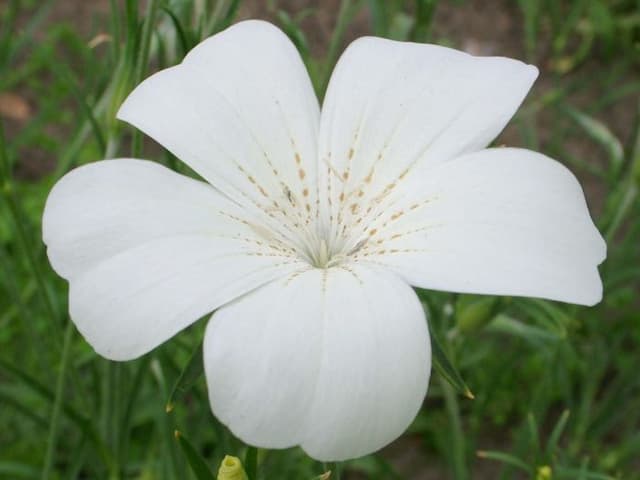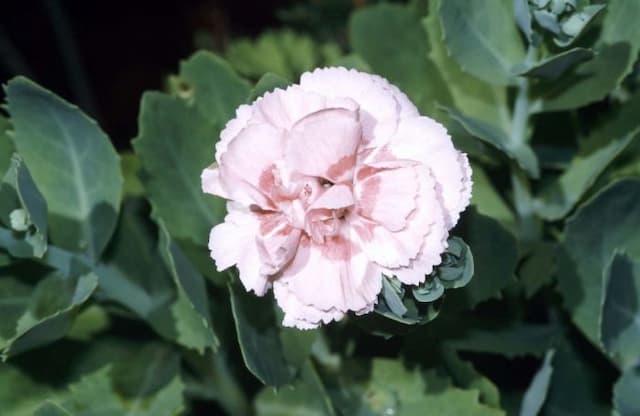Pinks Dianthus Sunflor Charmy = 'Hilcharm' (Sunflor Series) (pt)
![pot carnation [Sunflor Charmy]](/_next/image?url=https%3A%2F%2Fplants-admin.emdemapps.com%2Fimages%2Fplants%2F%2Fimages%2F604b5637d2575.png&w=3840&q=75)
ABOUT
The Dianthus Sunflor Charmy, part of the Sunflor Series, is a vibrant and attractive plant that is particularly known for its stunning flowers. The blooms of this plant have a distinctive appearance, marked by a blend of two colors. They often exhibit a unique pattern where the base of the petals is one color, which then transitions or gradates into a different shade towards the frilly petal edges. The flowers typically showcase a mix of warm tones—such as pinks, reds, and coral hues—that add a splash of color to any setting. The leaves of the Dianthus Sunflor Charmy are slender and elongated, providing an elegant dark green backdrop to the vivid flowers. This foliage emerges from sturdy stems which hold the flower heads proudly above them. The perfect contrast between the green leaves and the brilliant flowers makes this plant a favorite among gardeners looking for a plant that provides visual interest without requiring extensive care. The overall impression of the Dianthus Sunflor Charmy is one of cheer and charm, thanks to its bright, cheerful blossoms that can enliven any space with a touch of nature's artistry. It is a plant that is both pleasing to the eye and ideal for lending a burst of color to gardens and containers alike.
About this plant
 Names
NamesSynonyms
charmy pinks
Common names
Dianthus Sunflor Charmy = 'Hilcharm' (Sunflor Series) (pt).
 Toxicity
ToxicityTo humans
The plant commonly known as Pinks or Carnation in the Dianthus Sunflor series is not known to be toxic to humans. There are no well-documented cases of poisoning from ingesting parts of this plant.
To pets
Pinks or Carnation, part of the Dianthus Sunflor series, are generally considered non-toxic to pets as well. However, ingesting large quantities may cause mild gastrointestinal discomfort in some animals, such as vomiting or diarrhea. If a pet shows signs of distress after consuming the plant, it's advisable to consult a veterinarian.
 Characteristics
CharacteristicsLife cycle
Perennials
Foliage type
Evergreen
Color of leaves
Blue-green
Flower color
Mixed
Height
1 foot (30 cm)
Spread
1 foot (30 cm)
Plant type
Herb
Hardiness zones
6
Native area
Europe
Benefits
 General Benefits
General Benefits- Easy to Grow: Dianthus Sunflor Charmy is known to be an uncomplicated plant that's easy for beginners and doesn't require extensive gardening skills.
- Long Flowering Period: The plant produces blooms for an extended period, often from late spring to early fall, providing color in the garden for many months.
- Attracts Pollinators: The flowers attract bees, butterflies, and other pollinating insects, which are beneficial for the garden ecosystem.
- Drought Resistant: It is relatively drought-tolerant once established, making it suitable for regions with lower rainfall or for gardeners who prefer low-water-use plants.
- Versatile Uses: It can be planted in garden beds, containers, and borders, offering flexibility in landscaping and garden design.
- Cold Hardy: The plant can tolerate cooler temperatures, which makes it suitable for gardens in temperate regions.
- Compact Growth: The Sunflor series, including Charmy, generally exhibit a compact, neat growth habit that fits well in small spaces or as part of a mixed display.
- Colorful Blooms: The Dianthus Sunflor Charmy boasts vibrant, colorful flowers that can brighten up any garden space.
- Low Maintenance: It requires minimal upkeep beyond basic watering and occasional feeding, making it ideal for those who want a beautiful garden without a lot of work.
- Deer Resistant: The plant is known to be less appealing to deer, which can be beneficial in areas where deer browsing is a problem.
 Medical Properties
Medical PropertiesThis plant is not used for medical purposes.
 Air-purifying Qualities
Air-purifying QualitiesThis plant is not specifically known for air purifying qualities.
 Other Uses
Other Uses- Edible decoration: The petals of the Carnation can be sugared or used fresh to decorate desserts and add a slight spicy flavor to sweets.
- Bookmarks: Dried Carnation petals can be laminated or pressed to create natural, fragrant bookmarks.
- Coloring agent: Carnation petals can be used as a natural dye for fabrics and artisan crafts, providing a range of pink hues.
- Natural pest repellent: Carnations produce a fragrance that can deter certain garden pests, making them useful companion plants in a garden setting.
- Perfumery: The essential oil of Carnation is used in perfumes and scented products to impart a spicy, floral note.
- Candles and potpourri: Dried petals and essential oils of Carnations can be incorporated into candles and potpourri for their aroma.
- Floral baths: Fresh or dried Carnation petals can be added to bathwater for a luxurious, aromatic experience.
- Homemade paper: Incorporating Carnation petals into homemade paper can add texture and visual appeal to the final product.
- Gourmet teas: Some specialty gourmet teas include Carnation petals for flavoring and visual appeal.
- Art supplies: Pressed Carnation petals can be used in art projects, such as making natural collages or adding embellishments to handmade cards.
Interesting Facts
 Feng Shui
Feng ShuiThe Dianthus is not used in Feng Shui practice.
 Zodiac Sign Compitability
Zodiac Sign CompitabilityThe Dianthus is not used in astrology practice.
 Plant Symbolism
Plant Symbolism- Love: Dianthus is often associated with love and romantic feelings, reflecting the traditional language of flowers where it symbolizes deep affection and admiration.
- Passion: The vibrant colors and spicy fragrance of Dianthus can signify passion, suggesting a strong emotion or desire in relationship contexts.
- Gratitude: Gifting Dianthus, especially in the Sunflor series, can be seen as a token of thanks, showing appreciation for someone's kindness or help.
- Pureness: The flower's bright hues and sweet scent are sometimes related to the idea of purity and innocence.
- Boldness: The hues and patterns of Sunflor Charmy Dianthus may represent daring or courage, encouraging individuals to take bold actions.
 Water
WaterPinks, or garden pinks, like Dianthus Sunflor Charmy, should be watered thoroughly, allowing the soil to become moderately dry between waterings. They prefer not to sit in wet soil, thus overwatering can lead to root rot. For potted plants, this might mean watering once a week with about 1 to 2 gallons, depending on the size of the pot and the environmental conditions. During hot, dry periods, they may require watering twice a week, whereas in cooler, moist conditions, less frequent watering is required. Monitor the soil moisture regularly and adjust your watering schedule accordingly to maintain optimal health for the pinks
 Light
LightGarden pinks like Dianthus Sunflor Charmy thrive in full sun conditions, receiving at least six hours of direct sunlight daily. They perform best when placed in a spot where they can enjoy bright, unfiltered sunlight, which promotes vigorous blooming and healthy growth. If grown indoors, a south-facing window is ideal to provide the high light levels this plant craves
 Temperature
TemperatureGarden pinks like Dianthus Sunflor Charmy perform best in cooler temperatures, thriving in a range between 60 and 75 degrees Fahrenheit during the day and cooler at night. They can tolerate temperatures down to 40 degrees Fahrenheit and high temperatures up to 85 degrees Fahrenheit, but optimal growth occurs within the cooler end of this range. Extended periods of heat can be stressful for the plant, so providing some afternoon shade during the hottest parts of summer can be beneficial
 Pruning
PruningPruning garden pinks like Dianthus Sunflor Charmy is essential for maintaining a compact shape, encouraging new growth, and promoting more blooms. Deadheading, or removing spent flowers, should be done regularly to extend the blooming period. A more thorough pruning to remove about one-third of the plant's height can be done after the first main flush of blooms has finished, often in late spring or early summer, to rejuvenate the plant
 Cleaning
CleaningAs needed
 Soil
SoilThe best soil mix for Dianthus, commonly known as Carnation or Pink, is well-draining, loose, and fertile with added organic matter. A mix of one part garden soil, one part peat or coco coir, and one part perlite or sand is ideal. The pH should be slightly alkaline, between 6.7 and 7.3. Regular feeding with a balanced fertilizer will support healthy growth.
 Repotting
RepottingCarnations, like the Dianthus Sunflor Charmy, should be repotted every 2-3 years to refresh the soil and accommodate root growth. It is best to repot in the spring after the danger of frost has passed but before the onset of extreme heat.
 Humidity & Misting
Humidity & MistingDianthus, commonly known as Carnation, prefers a moderate humidity level. While they are relatively tolerant to different humidity conditions, they thrive best with humidity levels around 40-60%. If the air is too dry, particularly indoors, a pebble tray or occasional misting can help maintain an appropriate level of moisture in the air.
 Suitable locations
Suitable locationsIndoor
Place in bright indirect light, use well-draining soil, and ensure moderate humidity.
Outdoor
Plant in full sun with well-draining soil and water regularly.
Hardiness zone
4-9 USDA
 Life cycle
Life cycleThe life of Dianthus Sunflor Charmy begins with seed germination, typically initiated under controlled nursery conditions or within a favorable temperate climate. Seedlings emerge and develop a rosette of narrow, green foliage, which is followed by the vegetative stage where they grow and establish robust roots. As the plant enters the flowering stage, stems elongate, and vibrant, fragrant flowers bloom, showcasing a range of colors from pink to red and sometimes with variegated patterns. This perennial plant may go dormant in colder winter conditions, only to resume growth and rebloom with the return of warmer weather in spring. The plant can be propagated through division or cuttings, leading to new plants that undergo the same life cycle. Throughout its life, the Dianthus Sunflor Charmy requires regular maintenance including adequate sunlight, water, and pruning to encourage ongoing health and repeat blooming.
 Propogation
PropogationPropogation time
Spring to early summer
Propogation: For the Dianthus Sunflor Charmy, a popular method of propagation is by cuttings. This method is typically undertaken in late spring to early summer when the plant has plentiful growth to spare for cuttings. To propagate by cuttings, select a healthy, non-flowering stem and make a clean cut to create a 3 to 4-inch piece (approximately 7.5 to 10 centimeters). Remove the leaves from the lower half of the cutting and dip the cut end into a rooting hormone to encourage root development. Then, insert the cutting into a moist, well-draining potting mix. Keep the cutting in indirect light and maintain the soil moisture until roots have established, which usually takes a few weeks. After rooting, the new plants can be transplanted into individual pots or directly into the garden.








![Pink [Bubblegum]](/_next/image?url=https%3A%2F%2Fplants-admin.emdemapps.com%2Fimages%2Fplants%2F%2Fimages%2F604b596f31cbb.png&w=640&q=75)
